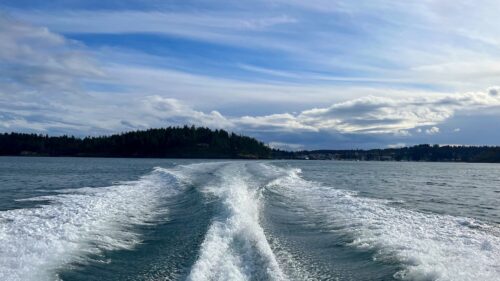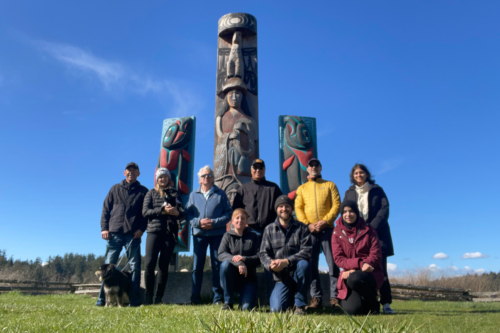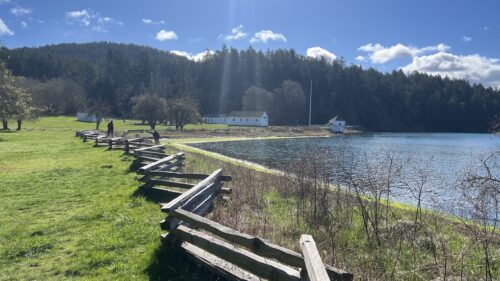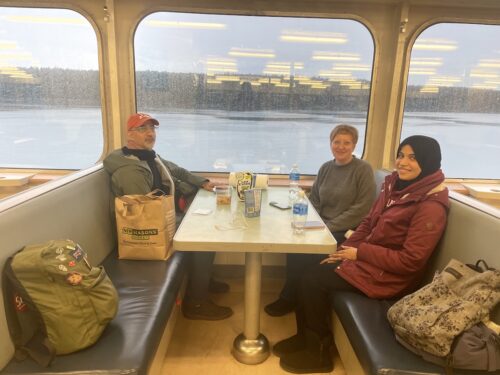Menu
ESI Stories
Our trip to Coast Salish ancestral land with Se’Si’Le
June 21, 2023
by Briana Meier, Postdoctoral Associate
The ferry ride from Anacortes to Friday Harbor, Washington, elicits exclamations from passengers struck by the beautiful views as the vessel winds through the San Juan Islands. On a recent trip to Friday Harbor to meet with our project partners at the Indigenous-led nonprofit Se’Si’Le, I joined my ESI colleagues—Norhan Bayomi, Supreetha Krishnan, and John Fernández—peering out the windows with tourists and locals in search of wildlife like the Southern Resident orcas whose home waters the ferry traverses.

The waters of the San Juan Islands
Those breathtaking views were on the mind of Jay Julius W’tot Lhem, Se’Si’Le founder and president and former Lummi tribal chairman, when we spoke to him the next morning in Friday Harbor. He told us of his wish for newcomers to the Coast Salish territories to understand how the landscapes we found so beautiful are a source of immense grief for Jay and other tribal people of the region. To understand this grief, Jay said, we must all learn to look to the past.
Later, we walked with Jay as he paced the 500-foot length of a now absent Coast Salish longhouse that once stood at the shore of what is now known as Garrison Bay on the northwest side of San Juan Island. This place, a national historic park now known as English Camp, is full of historical relics, but this history reflects only the military colonial moment that began in the 1800s.

The ESI team and our friends and partners at the totem pole sculpture in “English Camp.” Standing: Jay Julius W’tot Lhem, Jessica Newley, Kurt Russo, Dana Wilson, John Fernández, Supreetha Krishnan. Kneeling: Briana Meier, John Vechey, Norhan Bayomi
Our group that morning included John Vechey, founder and president of Pluto VR, who enlisted us to capture images of a contemporary totem pole sculpture—the single structure on the site representing thousands of years of Coast Salish heritage. John Vechey and Se’Si’Le plan to use these images in a new virtual reality exhibit in Friday Harbor that will introduce visitors to this all-too-often erased history.
ESI, Se’Si’Le, and Pluto VR are partnering to develop virtual reality designs to share ancestral knowledges in service to protecting and restoring sustainable ways of living with the Earth. We believe that immersive experiences like the VR exhibit in Friday Harbor can be powerful tools for building empathy and solidarity with the loss and struggles of tribal peoples in the region—for transmitting the simultaneous experience of beauty and grief present in the landscape today.

The national historical park now known as “English Camp” on the site of a former Coast Salish village
In the coming months, The Climate Machine—Bayomi and Krishnan’s program combining art, technology, and climate stories—will partner with two students from ESI’s Rapid Response Group to develop a visual narrative for a “Journey Through Time,” an audio-reactive visualizer that narrates an experience of climate change impacts over time. The visualizer will be developed using a combination of AI-generative art and original visual media. It will tell the story of orca populations in the San Juan Islands in a changing climate, and the relationship between the Coast Salish peoples, the orcas, and their traditional lands and waters. This visualizer will be the seed for a larger immersive experience that combines VR and AR.
This summer, I am leading a second Rapid Response Group student team in partnership with Se’Si’Le and other Pacific Northwest nonprofit organizations that are working to restore the Snake River and protect salmon, orcas, and treaty rights. This fall, we will conduct field research during a series of public events led by Se’Si’Le and intended to raise awareness about these issues.

John Fernández, Briana Meier and Norhan Bayomi on the ferry through the San Juan Islands
Se’Si’Le, led by Jay Julius and Dr. Kurt Russo, joins us as a critical partner in the ESI Climate Justice Program’s efforts to integrate Indigenous ancestral knowledges into MIT’s climate action work and support climate justice for Indigenous communities. Our partnership was sparked during Se’Si’Le’s first visit to MIT in April 2022 for the Living Climate Futures symposium and our first visit to Friday Harbor in July 2022. Our April 2023 trip has launched a new phase of the partnership. We look forward to continued work with Se’Si’Le as we develop the virtual reality heritage experience, the Climate Justice Program, and plan for an Indigenous Climate Justice Forum at MIT in 2023-2024.















